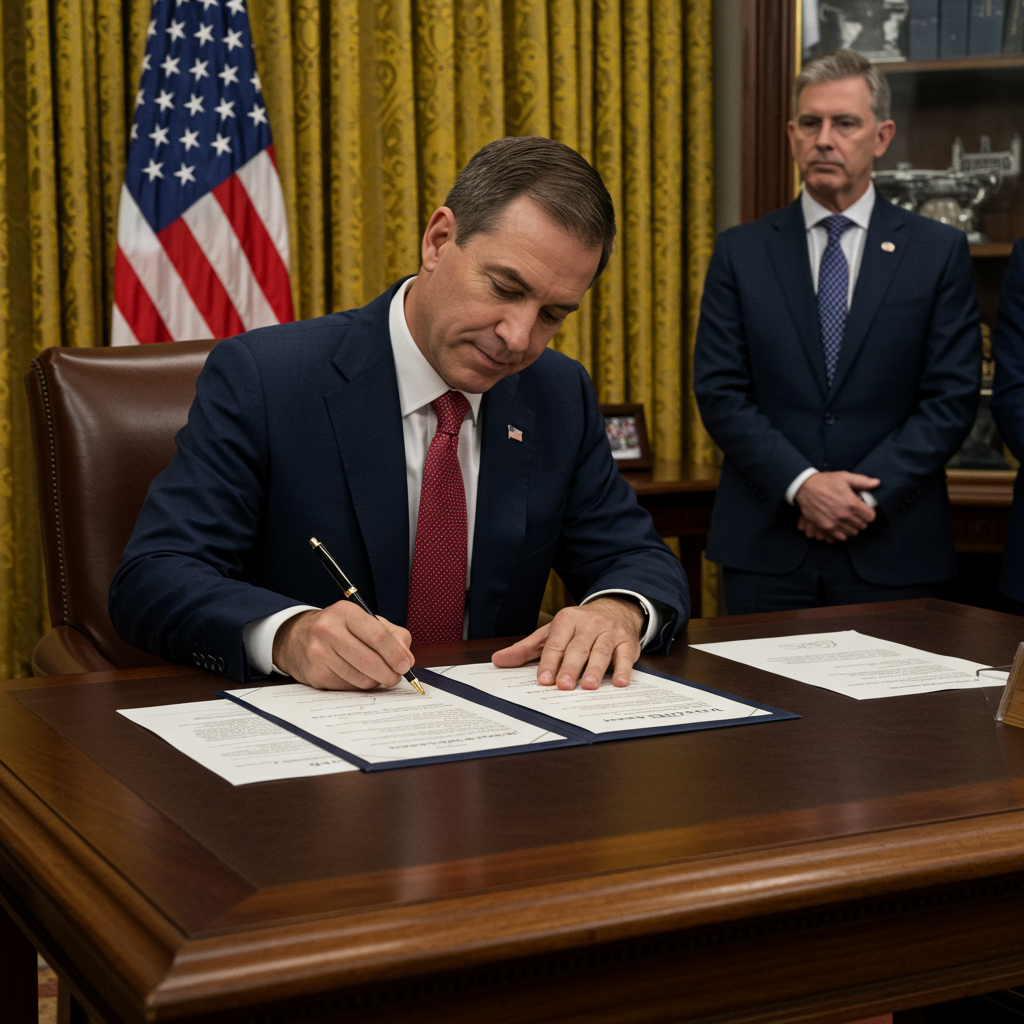As the second term of president Donald trump continues, significant legislative actions, economic reports, and legal challenges are shaping the national landscape. From contentious tax and immigration policies clearing Congress to the Supreme Court addressing complex social issues, and new data offering a nuanced view of the labor market, key developments are unfolding rapidly. This report provides a detailed look at some of the most critical recent events, synthesizing official announcements with expert analysis and broader context to give a complete picture of the current political environment.
Congress Passes Sweeping GOP Tax and Immigration Bill
A major legislative victory for Republicans and the Trump administration was achieved this week with the passage of a comprehensive tax and immigration bill through both the House and the Senate. The bill, which faced a July 4th deadline for President Trump’s signature, passed the House in a tight 218-to-214 vote, largely along party lines with only two Republican defections. This followed its earlier approval by the Senate.
House Speaker Mike Johnson signed the bill, paving the way for a planned signing ceremony by President Trump on Friday. The administration has aggressively pushed for this legislation, with reports indicating President Trump engaged in a “charm offensive,” including offering signed merchandise and photos in the Oval Office, to secure support from hesitant House Republicans. Some lawmakers reportedly emerged from meetings with a “newfound appreciation” after receiving these personal gestures. Representative Randy Fine publicly stated a primary motivation for his support was backing the president and delivering a signature achievement, downplaying specific provisions.
However, the bill has drawn significant criticism for its contents and potential impacts. It is described by opponents as significantly cutting social programs and heavily favoring corporations and the wealthy through extended tax breaks from the 2017 plan. Specific programs targeted for cuts reportedly include Medicaid, the Supplemental Nutrition Assistance Program (SNAP), and the Affordable Care Act (ACA). Estimates suggest changes to Medicaid and the ACA could result in at least 17 million Americans losing health insurance by 2034. While President Trump has claimed the bill would not tax Social Security benefits for seniors, the legislation reportedly does not include this provision. Instead, some seniors not receiving Social Security might see a short-term standard deduction increase, while those on Social Security receive no such benefit.
Democratic Minority Leader Hakeem Jeffries strongly opposed the bill, labeling it the “largest cut to health care in American history” and an “all-out assault” on Americans’ health care. He contrasted the bill with Trump’s past promises to protect key entitlement programs like Social Security, Medicare, and Medicaid, arguing that instead of lifting people up, this budget “tears people down.” Reports also surfaced suggesting President Trump may not have been fully aware of all the bill’s details; during a meeting aimed at garnering support, he reportedly stressed the need to leave social programs untouched, only for a member of Congress to inform him that Medicaid was being cut in the bill.
Nuance in the June Labor Market Report
Official data released by the Labor Department painted a seemingly positive picture of the U.S. labor market in June, reporting the addition of 147,000 nonfarm jobs. This pushed the unemployment rate down to a low 4.1 percent. However, a deeper analysis reveals a more complex and less uniformly robust situation than the headline numbers might suggest.
Expert analysis highlights a crucial detail: the slight drop in the unemployment rate (0.1 percent from the previous month) was significantly influenced by people leaving the labor market rather than finding jobs. The number of Americans who were neither employed nor actively seeking work reportedly increased by 234,000 last month, reaching a total of 1.8 million. This indicates the lower unemployment rate reflects a shrinking labor force participation rate rather than solely robust job creation. The overall labor force participation rate reportedly dropped to 62.3 percent, the lowest level recorded since 2022.
Further complicating the picture, different data sources within the report showed varying job gains. The household survey, used to calculate the unemployment rate, indicated a smaller gain of only 93,000 jobs, contrasting with the larger 147,000 figure cited from the establishment survey. Weaknesses were also noted in where the job growth occurred; gains were concentrated in just a few sectors, primarily healthcare, public education, and local government. The report also signaled a trend of slowing wage growth.
Economists are expressing caution against overstating the strength of the market based on headline figures. Cory Stahle, an economist at Indeed Hiring Lab, was quoted describing the market as “largely stand tall and sturdy” but potentially “increasingly held up by fewer poles.” While acknowledging the headline numbers as “undoubtedly good news,” Stahle suggested that for job seekers outside the concentrated sectors, the reported gains might “likely ring hollow,” concluding it was “not a bad report” but “might not be as solid as it seems.” This nuanced perspective indicates that despite a low unemployment rate, underlying trends point to areas of concern in the labor market’s health and breadth.
Supreme Court Takes Up Transgender Athlete Bans
In another development impacting social issues, the Supreme Court announced it will hear two cases challenging state laws that ban transgender athletes from participating in women’s and girls’ sports. These cases involve laws in Idaho and West Virginia. The decision signals the court’s engagement with contentious cultural issues that have been prominent in political debates, including commentary from President Trump himself.
This term’s decision to review these bans follows the Supreme Court’s action last month, where it upheld a Tennessee law prohibiting gender transition care for minors. The issue of transgender athletes in sports has also been a focus for the Trump administration; in February, President Trump signed an executive order aimed at withholding federal funds from educational institutions that allow transgender athletes to compete in girls’ and women’s sports. Advocacy groups such as the ACLU and Lambda Legal argue that these state-level bans are discriminatory and prevent transgender youth from benefiting from sports participation.
Administration Actions and Personnel Shifts
Within the executive branch, actions against government staffers have garnered attention. Roughly 140 Environmental Protection Agency (EPA) staffers were reportedly placed on leave after signing a letter of dissent criticizing the Trump administration’s management of the agency. An EPA representative justified the action by stating the agency has a “zero-tolerance policy for career bureaucrats unlawfully undermining, sabotaging, and undercutting the administration’s agenda.” This move highlights tensions between career staff and political appointees within federal agencies. Separately, Immigrations and Customs Enforcement (ICE) reportedly detained a former world champion boxer, though details surrounding this incident remain limited in the provided information.
Human Rights Concerns and Legal Challenges
The case of Kilmar Abrego García, a man wrongly deported by the Trump administration who was subsequently returned to the U.S. but now faces human smuggling charges, continues to raise significant human rights concerns. Lawyers representing Abrego García have detailed severe torture and mistreatment he allegedly endured while imprisoned in El Salvador following his deportation.
According to an amended civil complaint filed by his legal team, upon arrival at the Salvadoran prison known as CECOT, Abrego García was subjected to severe beatings, psychological torture, and deprivation of sleep and food. He reportedly received threats like, “Whoever enters here doesn’t leave,” was forced to strip, beaten for being too slow, had his head shaved, and was struck with batons, leaving visible bruises. Detainees were allegedly forced to kneel for approximately nine hours nightly and beaten if they fell from exhaustion. They were reportedly denied adequate bathroom access and confined to overcrowded, windowless cells with continuous bright lights and minimal sanitation. Prison officials allegedly threatened to transfer him to cells with gang members, despite acknowledging his tattoos were not gang-related – contradicting previous public claims made by President Trump based on a photoshopped image used to justify the deportation.
The case has also been a subject of misinformation in the media. During a segment on Fox News, guest Monica Paige falsely accused Abrego García of killing Americans while criticizing Democrats, an accusation that was fabricated as he has not been personally linked to deaths, though he faces disputed accusations of gang activity. Paige later issued an apology on X, clarifying she misspoke and meant to link him to gang activity that had caused deaths. This incident highlights how information surrounding high-profile immigration cases can become distorted.
Political Maneuvering and External Relations
Beyond policy debates, political dynamics within the administration and in relation to external figures continue to draw headlines. According to Trump biographer Michael Wolff, President Trump allegedly leaked information regarding Elon Musk’s purported ketamine use to The New York Times. This alleged action reportedly occurred after Musk criticized Trump’s budget bill as “pork-filled” and threatened to fund a new third party targeting lawmakers who did not reduce spending, suggesting a deterioration of the previously friendly relationship between the two figures and illustrating a potential response to political criticism.
Overall, these recent events underscore a period of intense activity across legislative, economic, judicial, and administrative spheres during President Trump’s second term, marked by significant policy shifts, ongoing legal battles, and complex political maneuvering.
Frequently Asked Questions
What are the key impacts of the new GOP tax and immigration bill?
The recently passed bill is expected to significantly impact social programs, reportedly leading to cuts in Medicaid, SNAP, and the Affordable Care Act, which could result in millions losing health insurance by 2034. It also extends tax breaks skewed towards corporations and wealthy individuals from the 2017 plan. While President Trump claimed it would exempt Social Security from taxes for seniors, this provision is reportedly not included in the final legislation.
What does the June jobs report reveal beyond the headline numbers?
While the report showed 147,000 jobs added and a low 4.1% unemployment rate, a closer look reveals that the decrease in unemployment was partly due to hundreds of thousands of people leaving the labor force, not finding jobs. Job gains were concentrated in specific sectors like healthcare and government, wage growth is slowing, and the labor force participation rate dropped. This suggests the market is stable but less robust than surface figures indicate.
What social issues are the Supreme Court addressing involving recent laws?
The Supreme Court has agreed to hear cases challenging state laws in Idaho and West Virginia that ban transgender athletes from women’s and girls’ sports. This follows a decision last month upholding a Tennessee law banning gender transition care for minors. These cases place the court at the center of ongoing debates about gender identity and rights in sports and healthcare.



